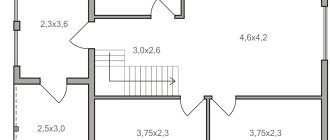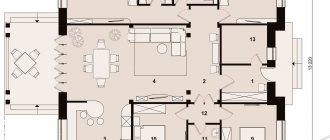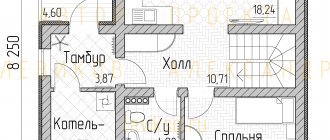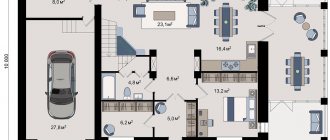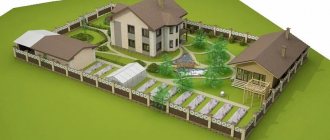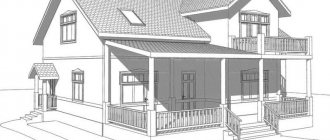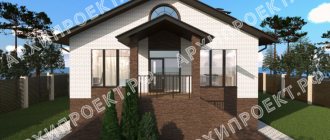Standard design of buildings being built using budgetary funds may be introduced in Russia in 2021. We are talking about schools, kindergartens, libraries, hospitals and other facilities. As Izvestia found out, the Ministry of Construction submitted to the government a bill amending the Urban Planning Code of the Russian Federation, suggesting the appearance of such design in Russia. The initiative is ready to be supported in the relevant State Duma committee on construction, as well as in all factions. Experts also believe that this measure will significantly reduce the cost of building construction.
Why do you need a project when building a house?
The topic of design has been repeatedly raised in articles, a separate thread is devoted to it on the forum, but still, there are adherents of perhaps the most famous postulate in construction - “before, everything was built this way and nothing happened.” And the notorious “so” is truly, universal - this is without a project, and without calculations, and without insulation, and without many other things that are considered mandatory today. Yes, some actually succeed in this way, and some end up with a long-term construction project or alterations, but these are the very exceptions that confirm the rule - the house must be built according to the project.
And yet.
spacewalker FORUMHOUSE participant, architect
...I've been on the forum for almost 10 years. It has been stated a million times that the project is an integral part of the enterprise “building your own home.” If people have no money (and there is no permanent money - the standard: the population does not know how to plan and distribute expenses, in the paradigm of the average person it is easier to pay for a dubious few extra m² than to bother with high-quality, predictable, construction of an aesthetically sound harmonious house), the project, the last, What are they thinking about, because “the grandfathers somehow built without these projects of yours.”
In addition, doubts arise simply due to a lack of understanding why the project is needed at all.
Sergey KochkinForumHouse Member
This is my first time writing here, I mostly read the comments of others. Last year I took a plot, and I plan to build it on my own. I looked at others’ self-constructions without a project and am inclined to believe that one is needed. The question is, what is the project needed for more? Only for construction or for processing other documents, for example, to obtain a permit or commissioning? I am a beginner and would like to have my own reliable piece of paper for each piece of paper. Something like this.
Victoria LokhtinaHead of Client Service at Dom.Team
Main purpose of the project:
- accurate understanding of the budget and reducing the risk of unexpected expenses;
- an optimally priced and at the same time reliable foundation, its calculation is made by an experienced engineer;
- visualization of the project helps to clearly understand what the house will look like (modern technologies allow you to walk around the house on a monitor or using virtual reality glasses);
- working drawings allow for accurate acceptance of work based on documents rather than words (less disputes with the contractor, more specifics);
- obtaining a construction permit (as a rule, a preliminary design/architectural passport is sufficient.
If you plan to build on your own, we strongly recommend ordering a complete package of documentation (AR plus KR or a general album AC) to avoid mistakes in construction.
If you don’t calculate, for example, the foundation and don’t take into account the geology of the site, and even get by without drainage, this could happen.
And when the architectural section is developed separately from the engineering section, the result is as in the well-known aphorism - it would be funny if it weren’t sad.
Last but not least, the negative attitude towards design is based on problems with qualified specialists. No one is immune from this, but it is possible to minimize the risk.
Designer_Participant FORUMHOUSE
The advantages have already been outlined above - the project allows you to get reliable structures for the least possible money. Disadvantages - you can run into an unqualified designer, as a result of which the structures will be unreliable and construction will be expensive. Avoiding disadvantages is difficult. Partially, collecting information about the designer can help with this; communicate with him, ask him “stupid” questions and watch how he answers them and how he justifies them; own intuition; examination of design solutions by third-party specialists.
A project is definitely needed, we’ll figure out which one it is.
Development of communal apartments
During the Great Patriotic War, housing construction was greatly reduced, since all industrial capacities had to be used to ensure the country's increased defense capability. However, starting in 1944, as a result of the liberation of previously occupied territories, the construction industry again began to gain momentum due to the need to restore the destroyed housing stock, which had been lost to a very large extent. Immediately after the war, standard residential housing construction received top priorities, and all old projects were modified with the requirement to increase the speed of construction of buildings. New, higher quality projects have also emerged, based on the use of new building materials and technologies.
Advantages and disadvantages of standard projects
Standard projects are developed by professionals and are aimed at meeting the average needs of most developers. Its main characteristic feature is its repeated use. Compared to the absence of a project as such, using a standard one is a blessing. The advantages of this type include:
- Availability – there are a lot of sources of standard projects on the Internet for little money; if you search, you can find them for free; many people post their documentation on the forum or share it in a personal message. And if purchased from a specialized company, the cost of the TP is an order of magnitude lower.
- Speed – everything has already been invented and tested many times; you don’t have to waste time on development and adjustment.
- Variability – if desired, a standard project can be modified to suit your needs.
It would seem - take it, save it, build it and be happy; but not everything is so simple. For example, a common situation is when the customer seems to pay less, but does not understand what he is buying and they take advantage of it.
jafar2000FORUMHOUSE Member
What should the documentation for building a house contain? Here they are designing a house for me, I ask them questions about the location of the water supply, heating, electrical wiring, how the insulation is laid under the foundation. And they tell me that this applies to wiring diagrams. And here I am at a loss - why then the project? How to build on it? Thank you in advance.
Victoria Lokhtina
Most likely, you purchased a preliminary design (DS). It contains layouts, elevations, sections, visualization and reference to the site. In order to have all the necessary components and circuits, it is necessary to prepare sections AR and KR. Here's what you can do with EP:
- understand what your future home will look like, approve the layout and floor heights;
- create an approximate budget for construction before preparing working documentation.
It's a shame that the designers didn't inform us about this. Sometimes this is done in order to “grab” the order and sell the full set of documentation already during the design process.
As for saving time on preparation, although the TP has already been developed, it still needs to be “tied” to the site, taking into account its dimensions and shape, topography, solarity and views, and this also takes time. Yes, and with revision it’s not so simple.
ThunderstormForumHouse Member
I want to understand whether it is worth buying a standard project, because at the same time, you will not protect yourself 100% from shortcomings - it may also contain them. For some, a standard layout is good, for others, not at all. And if you have no construction experience, the project will not save you from mistakes, but if you have experience, then your head will work even without a project. And I’m not saying that it’s possible without a project at all, I’m saying that some points can be worked out with a specialist.
So it probably turns out that you can leave the standard roof (if without modification). Consider the foundation, finalize the layout, floors, the design can be changed, some with profiled sheets, some with voids (we are looking for a cheaper option, as a rule, we can’t bring slabs from someone, depending on who.) And the load-bearing walls in all projects are the same, everything counted. I wanted to understand the usefulness of a typical project, that this is really money that is not wasted... Or is it worth spending money on creating what you want, and not on something that you need to redo for yourself.
Victoria Lokhtina
That's right, standard projects often contain technical errors and shortcomings. Economically unfeasible solutions are also being laid (in particular, a deep foundation strip). The fact is that they were developed, as a rule, for specific clients. Constructive solutions are laid either “for the client” or for specific conditions on the site. As a result of purchasing a finished project, you should:
- remodeling layouts (additional $);
- foundation adaptation (additional $);
- link to the site and project passport (additional $);
- or perhaps you want the same house in a different technology (pay another $$$).
In total, its cost can be multiplied by approximately 2.
Very often, the finished project is put on the table and people begin to design again, individually. And money spent on a finished project becomes wasted. I have seen quite a lot of such examples.
The era of expansion of the Russian Empire to the East
Also, an undoubted development in the standard construction of residential buildings, at least in our country, can be considered the era of the expansion of the Russian Empire to the East, when new cities arose literally in dozens every year and required rapid settlement. In such conditions, it was often simply impossible to build something individual, due to lack of time to develop the project, so the builders used real standard projects, which made it possible not only to speed up construction, but also to reduce its cost, and significantly. The era of Peter I significantly strengthened the scope of standard construction - the emperor personally forbade the common people to build individual buildings in the new capital, St. Petersburg, that required a long construction process.
He demanded that court architects develop several standard designs with established building dimensions. The emperor personally founded workshops in which wooden structures of future buildings were literally produced using a conveyor belt method - standard log cabins, fences and other building elements. He also ordered the mechanization of the construction sector, so special “saw mills” appeared in the capital, which took advantage of the fast flow of the Neva - this saw the sawing of logs much faster, and accordingly, the construction time for buildings was reduced.
This whole practice quickly spread throughout Russia, and where the need arose, standard designs for residential buildings found their application, for example, in the industrial centers of the Urals and Little Russia.
Advantages and disadvantages of custom design
An individual project is developed from scratch by a professional to meet the requirements and conditions of a specific customer. A second house for such a project can only appear with the consent of the customer, if he decides to share, and it will not “migrate” to the standard section of the performers. IP has enough advantages.
- Exclusivity - in most cases, the house will be in a single copy.
- Originality is a special geometry, a specific layout, and unique space-planning solutions.
- Convenience - a house that is completely designed for itself, taking into account the needs of all household members, always outperforms a standardized one.
- Ideal “fit” - unlike a standard one, which is adjusted to the site as much as possible, an individual one is immediately developed for all the features, which allows you to level out the shortcomings.
Individual projects have two disadvantages.
Victoria Lokhtina
Individual design allows you to take into account all the interests of the client and build a house according to his ideas and needs. However, there are pitfalls here too.
- First, designers often do not have construction experience, and there is a risk of making mistakes and economically unjustified decisions. As a result, changes to an already “ideal” house design have to be made at the construction site.
- Secondly, the price of this service on the market is high; on average, design will cost from 100 to 300 thousand rubles.
Considerable sums, especially if the construction is in economy mode, but they will justify themselves.
I789 FORUMHOUSE participant
Could not find a standard project. We ordered an individual one. The toad was choking terribly. Upon completion of construction, the cost of the project was less than 2%. We received a house that fit us like a good glove for our hand. The result pleases the eye and soul. Take risks, the game is worth the candle.
Plus, there is an opportunity to reduce costs.
Victoria Lokhtina
Why buy a standard project and spend money on remodeling, if you can immediately make it for yourself - quite quickly and quite inexpensively. For example, we offer an individual design service at an affordable fixed price, so as not to make a mountain out of a molehill (usually, during the design process, the price of the project increases, since the actual area is larger than the planned one). We also understand that a project is a tool that should create a clear and optimal construction budget and save the contractor and client from problems during implementation.
The birth of communal apartments
This is how projects of modern communal apartments were born, designed to accommodate several families, albeit in separate living areas, but with a combined catering unit and bathroom. However, by the mid-50s, such projects were completely abandoned in favor of the construction of panel houses, the so-called “Khrushchev houses”. Such houses had a frame structure, the walls were made of insulated reinforced concrete panels. This technology allowed the construction of multi-story residential buildings in a short time, and by the early 60s the basic need for housing was largely satisfied. According to the same projects, residential buildings were built on collective and state farms, and in order to speed up construction, “Khrushchev houses” were built even in villages, albeit modernized ones - no higher than 4 floors, but mostly two-story and three-story.
However, the industrialization and urbanization of cities and towns continued, and at a fairly high pace, and therefore housing was constantly required. Brick construction was declining at a very rapid pace, while large-panel construction, on the contrary, was growing. For example, the volume of construction of large-panel residential buildings over 10 years (from the mid-50s to the mid-60s) increased almost 15 times. Thanks to improvements and changes made to the design of buildings and the layout of apartments (ceiling heights, the use of innovative materials for exterior decoration, combining bathrooms, etc.), the cost of housing has decreased by more than a third without losing the comfort of living. The cheaper and faster construction was also facilitated by the emergence of projects of 9-story and then 16-story buildings, which were built almost faster than 5-story “Khrushchev” buildings, but at the same time the level of comfort in them was slightly increased, for example, instead of the standard A 5-meter kitchen became a 10-meter kitchen, and the bathroom became separate again.
conclusions
A standard project is better than none, a completely viable option, but you need to understand that there will still be additional expenses, and it is unlikely that you will be able to build a house completely “for yourself.” Individual design is a real opportunity to provide yourself with the desired level of comfort. Risks exist, but they can be minimized, as can costs - on the scale of the general construction budget, the difference between “stamping” and exclusive is practically leveled out. But a comfortable, presentable and marketable house will remain.
Read more about the specifics of construction according to standard projects in the material “...Finishing it to suit you.” It will also be useful to read about the nuances of designing communications in a private home. The video is about BIM design.
Subscribe to our Telegram channelExclusive posts every week
